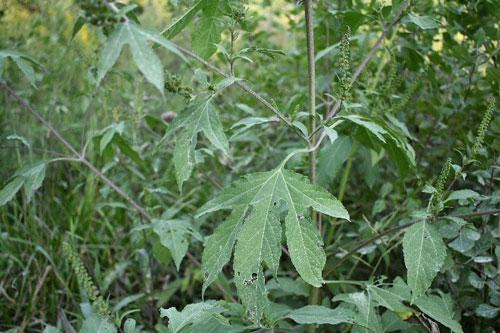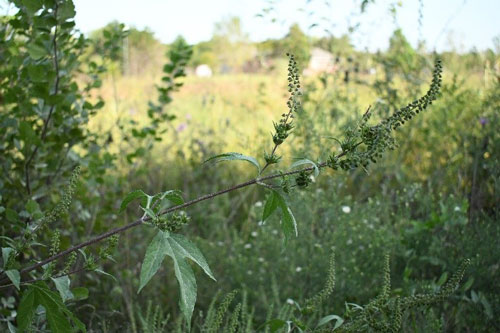Giant ragweed (Ambrosia trifida), also called horseweed, often comes to mind as a contributor to seasonal allergies in the fall. However, emergence of this weed begins in early spring, making it a timely topic for the March World of Weeds article.
Ecology of giant ragweed
There are several ragweed species that are native to North America. Species found in Kansas include two summer annuals, giant ragweed and common ragweed (see Table 1), and two perennials, western ragweed and woollyleaf bursage (bur ragweed). Wollyleaf bursage is a noxious weed in Kansas and was featured in Issue 820 on September 25, 2020.
|
Table 1. Key features that distinguish giant ragweed from common ragweed. |
||
|
|
Giant ragweed |
Common ragweed |
|
Distribution |
Throughout US |
Throughout US |
|
Height |
3 to 16 feet |
6 inches to 5 feet |
|
Stem |
Rough hairs when mature |
Hairs when young |
|
Leaves |
Opposite then alternate, 3-5 lobes, rough |
Opposite then alternate, many lobes, hairy |
Giant ragweed is often found in ditches and fencerows. It is a problem in cultivated crops, especially those in bottomlands, throughout the United States. Giant ragweed is an annual plant that emerges March through June, with peak emergence in Kansas in mid-April.
Identification
Seedlings emerge with large, fleshy cotyledons with a purple stem (Figure 1-top photo). Giant ragweed typically grows to about 5 feet tall, but can reach up to 20 feet in ideal environments. Stems and leaves are rough and hairy. Leaves are opposite and typically having three lobes, but there is variability in lobe number (Figure 1-middle photo). Leaves are 4 to 8 inches wide by 2 to 12 inches long with toothed margins.
Giant ragweed produces green flowers from July through October. Pollen-producing male flowers are clustered at the ends of the branches with seed-producing female flowers below the cluster (Figure 1-bottom photo). Brown, crown-shaped seeds with 6 points are 1/4- to 1/2-inch long and about 1/10-inch wide.



Figure 1. Giant ragweed seeding (top photo), leaves with differing number of lobes (middle photo), and flowers (bottom photo). Photos by Sarah Lancaster, K-State Research and Extension.
Management
Giant ragweed is very competitive, especially in soybean, where 1 plant per square yard can reduce yield up to 77%.
Giant ragweed in the United States has confirmed resistance to glyphosate (Group 9) and ALS-inhibiting herbicides including Pursuit, Classic, and FirstRate (Group 2), with glyphosate-resistant giant ragweed confirmed in Kansas (Table 2).
|
Table 2. Occurrence of herbicide-resistant giant ragweed in the US |
|
|
State |
Herbicide site of action group |
|
Arkansas |
9 |
|
Illinois |
2 |
|
Indiana |
2, 9 |
|
Iowa |
2, 9 |
|
Kansas |
9 |
|
Kentucky |
9 |
|
Minnesota |
9 |
|
Mississippi |
9 |
|
Missouri |
2, 9 |
|
Nebraska |
9 |
|
Ohio |
2, 9 |
|
Tennessee |
9 |
|
Wisconsin |
2, 9 |
|
Data from www.weedscience.org |
|
Studies conducted in Nebraska suggest that tillage or burndown application of 2,4-D provided excellent control of giant ragweed 14 days after treatment. In the same study, the greatest season-long weed control was recorded from treatments that included sulfentrazone at planting and/or multiple applications of glyphosate. Other effective herbicides include dicamba, metribuzin, Boundary, Envive, and Surveil.
Sarah Lancaster, Extension Weed Management Specialist
slancaster@ksu.edu
The use of trade names is for clarity to readers and does not imply endorsement of a particular product, nor does exclusion imply non-approval. Always consult the herbicide label for the most current use requirements. For more information on controlling marestail, see 2021 Chemical Weed Control for Field Crops, Pastures, Rangeland, and Noncropland, K-State publication SRP-1162.